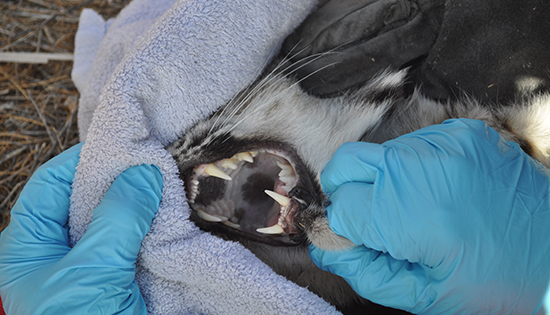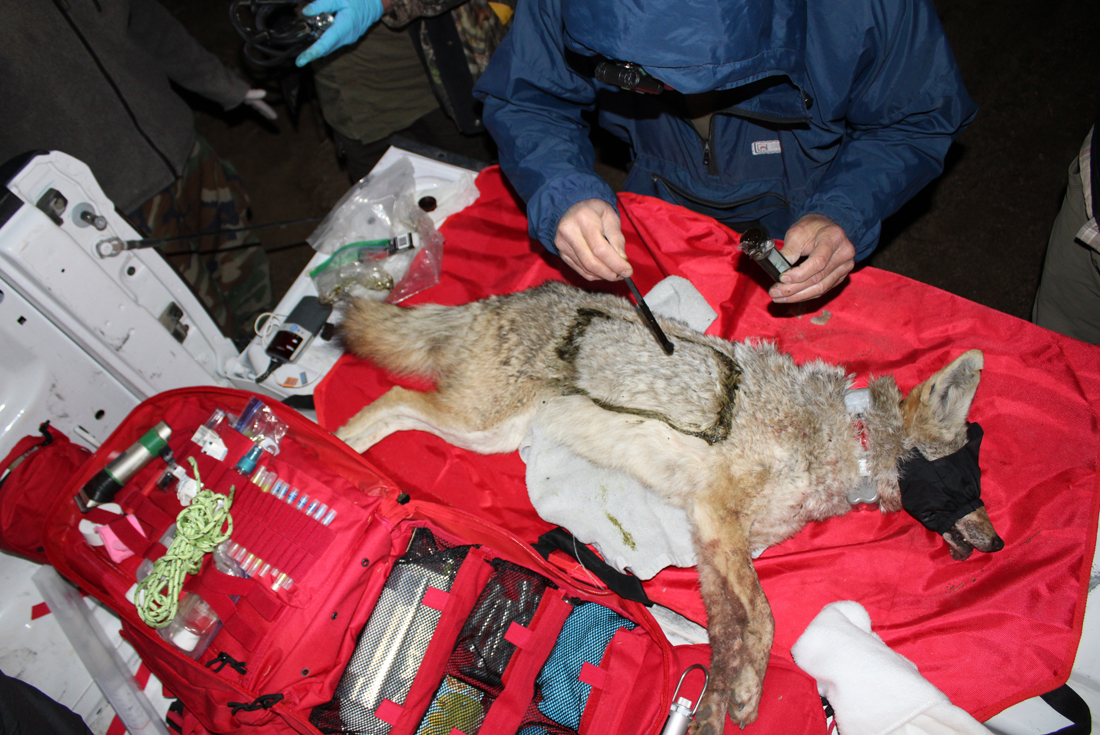BY JODI PETERSON

The carnivore trapping team was just finishing dinner on a mild spring evening when the capture signal came in. Somewhere near the team’s location on Edwards Air Force base, north of L.A., a coyote had followed its nose to a fascinating scent – but when it tugged on the lure, a neck cable snagged it securely. The snare didn’t harm the coyote, but the team didn’t want to leave the animal trapped any longer than necessary. “Suddenly, it was go time,” recalled Jennie Anderson, the principal investigator with the Center for Environmental Management of Military Lands who is overseeing the project at Edwards. Everyone dropped their plates, and within 10 minutes, Anderson, CEMML Wildlife Ecologist Adam Dillon, and five other team members, including a veterinarian, were on their way to the GPS location broadcast by the trap transmitter.
The team worked quickly to sedate the coyote, then put moistening ointment in its eyes and muzzled its jaws. They checked the animal’s health and sex, weighed and measured it, estimated age based on tooth wear, painted a symbol on its fur for visual identification, and finally, buckled a GPS tracking collar around its neck. The collar will stay on for a full year, broadcasting the coyote’s location 4 or 5 times a day.

The CEMML team hopes to collar a total of ten coyotes and ten bobcats this year within Edwards’ 300,000 acres, an area roughly the size of Denver. They’ll track the animals’ movements, determine how big their home ranges are, and figure out what food and water resources they rely on. Their goal is to help Edwards’ Natural Resource Division develop a plan for managing these carnivores, which often roam near the base’s schools, play areas, and housing, so that they can coexist peaceably with the base’s 2,500 human residents. A CEMML biologist, Steven Nagy, stationed at Edwards also answers calls to a wildlife hotline and takes reports about nuisance and injured animals. The latter are captured if possible and transported to a veterinarian or a wildlife rehabilitation center for treatment.
These desert coyotes and bobcats aren’t big – most of them weigh less than 20 pounds, due to the harsh, hot environment. Nor are they typically dangerous to humans, although they can, on rare occasions, carry rabies. Their usual menu consists of jackrabbits, birds, kangaroo mice, and ground squirrels. These prey species, as well as their predators, are all attracted by the water features, bird feeders, and shady bushes common in base landscaping.

To forestall such problems, said Anderson, you can’t just catch the carnivores and take them somewhere else: “As soon you take one out, another moves in.” Instead, with the help of the CEMML team, Edwards AFB wants to help residents learn to enjoy the presence of wild animals and be proud of the fact that they live on a base with a healthy ecosystem. The base encourages people to landscape with native vegetation, avoid putting out feeders, and haze bobcats and coyotes away when they come around. “The idea is to educate the animals about where they shouldn’t go,” said Dillon, “then just let them be and give them space.”
While these two creatures are the most common carnivores on Edwards, they’re far from the only ones. Its dry, scrubby landscape of creosote bush, saltbush, and Joshua trees, on the western side of the Mojave Desert, is also home to badgers, desert kit foxes, mountain lions, raccoons, spotted skunks, black bears, and ring-tailed cats. The CEMML team is helping Edwards track the ranges and numbers of these species as well, using dozens of camera traps placed randomly across the base. This data will be used to develop a baseline inventory of large mammals; the team will provide information to the Edwards Natural Resource staff on the best ways to monitor trends and changes in population. “Once we know the relative numbers of each species and where they are around the base, we can tell if an animal’s range is expanding or contracting,” said Dillon.

The spring trapping season ended in April, and during summer it’s too hot to risk having animals in traps. So the CEMML team plans to return to Edwards in the fall, to catch and collar more bobcats and coyotes. They’ll also move all the camera traps to new locations to continue recording the locations and numbers of other large mammals on the base.
When the biologists finished collecting data and samples from the coyote they’d caught, they administered another drug to help counter the effects of the sedatives. Within a few minutes, the animal began to lift its head. Soon it was standing up, and then it walked off into the brush. “It turned around and looked at us,” remembered Anderson, “with this expression like, ‘what just happened?’ Then it was gone.”
For more information about this CEMML project, contact Edwards AFB Environmental Management:
661-277-1401 ext. 3, or go to sites.warnercnr.colostate.edu/eafbcarnivores
 A member of the CEMML carnivore trapping team at Edwards AFB paints a unique identifying symbol on a captured coyote. CREDIT: CEMML
A member of the CEMML carnivore trapping team at Edwards AFB paints a unique identifying symbol on a captured coyote. CREDIT: CEMML